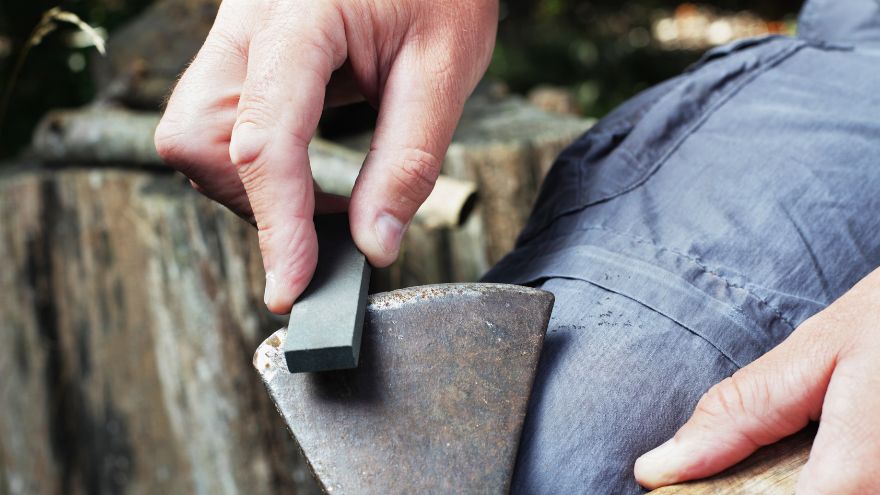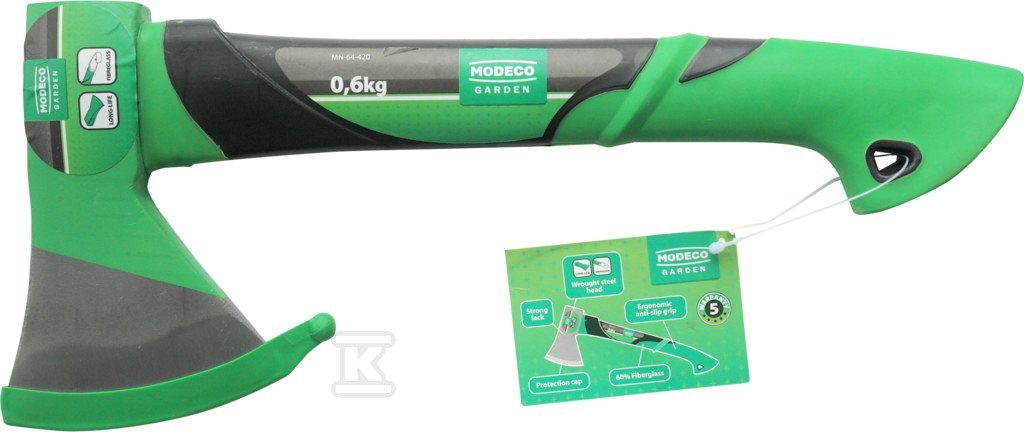Everyday work with an axe when quartering and chopping wood is much more convenient when the axe blade is properly sharp. Before you start any work and start chopping wood, make sure you know how to properly sharpen your work tool. A blade that is too blunt can make the cut wood uneven and cracked. So how should you prepare the axe blade for working with wood? In this guide, you will find practical tips for professionals.

Check out the axes at the Onninen wholesaler
How to prepare an axe for sharpening?
![Modeco Expert axe 1.25 kg, length 700 mm forged [GARDEN] MN-64-094](https://onninen.pl/lib/images/3895005.jpg) If you are going to sharpen an axe, make sure that the equipment is 100% functional, the handle holds the head firmly, and the blade is free of dirt and corrosion. When sharpening an axe , always take care of its cleanliness and the stable attachment of the head to the handle made of wood, plastic or steel.
If you are going to sharpen an axe, make sure that the equipment is 100% functional, the handle holds the head firmly, and the blade is free of dirt and corrosion. When sharpening an axe , always take care of its cleanliness and the stable attachment of the head to the handle made of wood, plastic or steel.
Any wood splitting tool should be stored in a dry place completely free of moisture. This is essential if you do not want the axe head to be destroyed by spreading corrosion.
When you put your axe away for a long time, don't forget to coat the blade with a little grease or other lubricating and protective substance. This will protect the axe head from corrosion.
How to sharpen an axe with a whetstone?
Both the splitting axe and the classic carpenter's axe with a straight blade should be properly sharpened. When axes cause burrs in the wood during work, then you need to think about sharpening your work tools.
![Modeco Expert axe 0.6 kg, length 360 mm forged [GARDEN] MN-64-090](https://onninen.pl/lib/images/3894983.jpg) To remove larger damage near the blade, you can use an emery disc, which will allow you to perfectly smooth the surface of the head as a result of grinding. In this case, be careful not to overheat the material - use a bucket of water to cool the axe often.
To remove larger damage near the blade, you can use an emery disc, which will allow you to perfectly smooth the surface of the head as a result of grinding. In this case, be careful not to overheat the material - use a bucket of water to cool the axe often.
If you are looking for equipment for professionals, a good choice would be the Modeco Garden 1.25 kg axe with a length of 700 mm . Alternatively, you can choose a compact model, the Modeco Garden 0.6 kg axe with a length of 360 mm . This is a short model that is ideal for gardening.
The whetstone is the most popular tool used for sharpening axes. Sharpening with a whetstone by hand should be done as follows (of course, caution above all):
- Moisten the whetstone with oil or water to help guide the stone across the blade.
- Choose the right sawing angle – optimally it will be in the range of 15-20 degrees.
- Adjust the pressure of your hand with the whetstone to the thickness of the blade on the head. When working with a whetstone, the pressure should be much lower than when working with a file.
- Using circular movements of the whetstone, grind the tip of the head with the blade on both sides alternately.
- After initial grinding, you will notice a burr on the blade surface - the notch can be removed by rotating the head several times and grinding it from one side to the other.
If your axe is sharp enough along its entire length for everyday use and you take regular care of its condition, then using a whetstone every once in a while is quite sufficient. In the case of more serious damage and a very blunt blade, a file will be a better choice.
Sharpening an axe with a file
Both axes and other garden tools can be sharpened with a file. Sometimes even a millimeter of burr can make the axe less comfortable to use – then it is best to sharpen it along its entire length at once.
 Equip your workshop with a professional Modeco Expert FIBREGLASS 1.8 kg axe with a length of 870 mm . This is a splitting model that, while maintaining the appropriate sharpness of the head, will allow you to conveniently cut wood and branches.
Equip your workshop with a professional Modeco Expert FIBREGLASS 1.8 kg axe with a length of 870 mm . This is a splitting model that, while maintaining the appropriate sharpness of the head, will allow you to conveniently cut wood and branches.
In connection with sharpening with a file, you must remember that the angle of the blade in relation to the file should be exactly 90 degrees. Only then will you be sure that no roundings will occur on the blade, and the use of the file will be safe for the head.
If you don't have much experience sharpening axes, remember to finish off the sharpening with a short series of grinds with a whetstone. This will keep the blade on the head perfectly even and sharp.